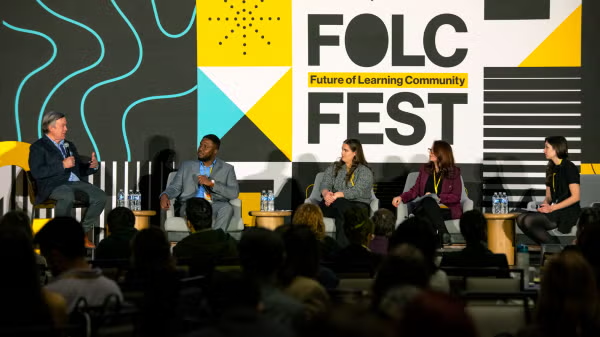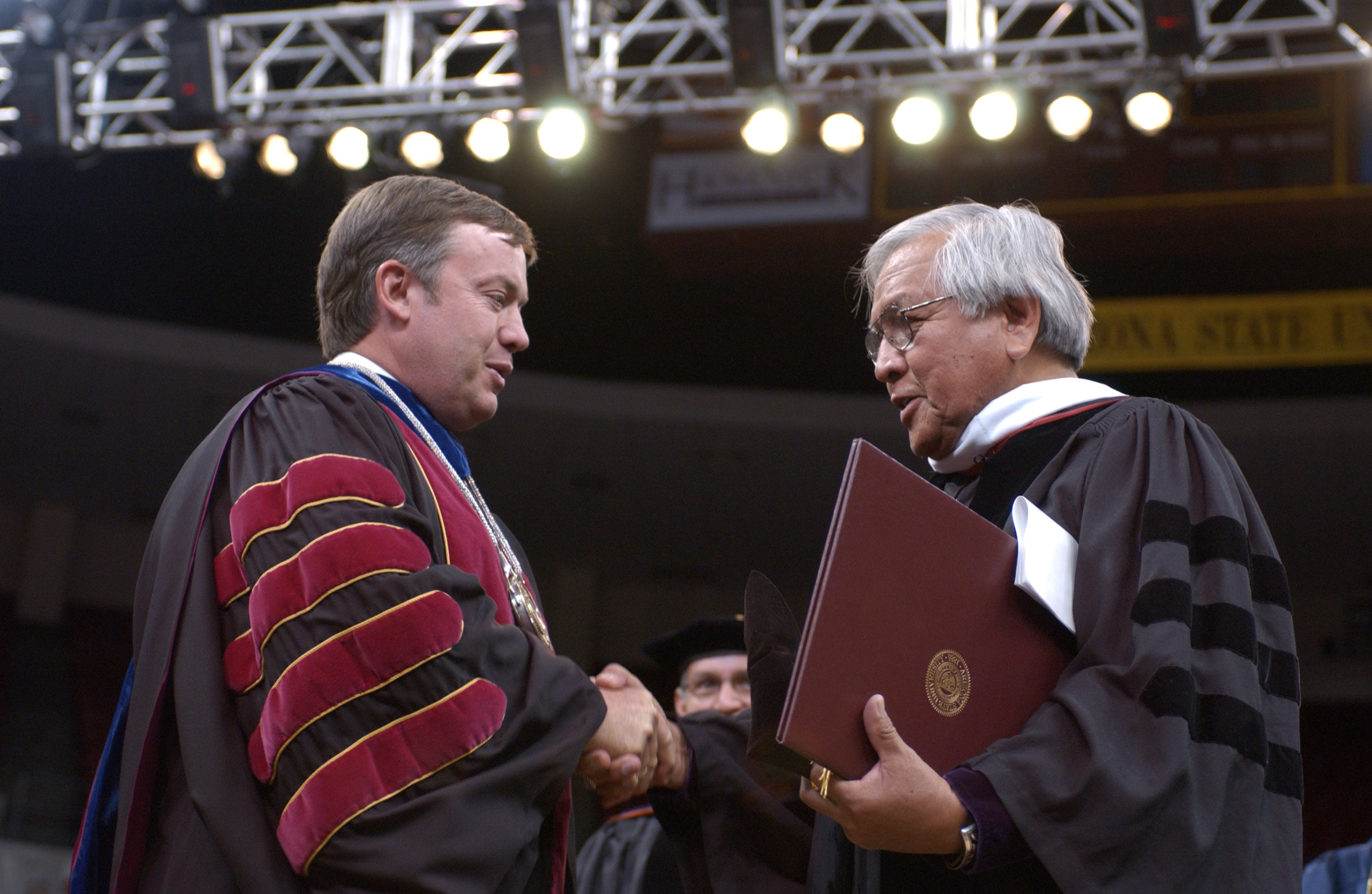ASU community mourns Sun Devil and former Navajo Nation President Peterson Zah

Peterson Zah speaks during the American Indian Convocation at Arizona State University in 2006. Photo by Tom Story/ASU
Editor’s note: This story is featured in the 2023 year in review.
Peterson Zah, the first president of the Navajo Nation and a graduate of Arizona State University, died Tuesday, March 7, at age 85.
Zah, who led the Navajo Nation from 1990 to 1994 and was a special advisor to ASU President Michael Crow, earned a bachelor’s degree in education from ASU in 1963 and was awarded an Honorary Doctoral Degree of Humane Letters from the Mary Lou Fulton Teachers College in 2005.
“I am saddened by the passing of Peterson Zah, a groundbreaking and courageous leader who shared his knowledge, passion for education and service, and generosity of spirit to make Arizona State University, Arizona and Indian Country better," ASU President Michael M. Crow said. "He set the standard for ASU’s commitment to American Indian students and tribal communities, and he will be deeply missed. Our condolences to the Zah family and the Navajo Nation.”
Zah was born in 1937 in Low Mountain, Arizona, and attended the Phoenix Indian School. After graduating from ASU, he returned to his community to teach carpentry to Navajo adults and then became a field coordinator for the VISTA Indian Training Center. He later co-founded and became executive director of DNA-People’s Legal Services, a nonprofit legal services program for Navajo, Hopi and Apache people.
Zah was chairman of the Navajo Nation Council from 1981 to 1987, and in 1990 became the first president of the Navajo Nation, which had changed its constitution to shift from a council governing model to a three-branch system: executive, legislative and judicial.
He was a lifelong advocate for education in the Navajo Nation. Just last fall, he met up with the ASU Tribal Nation Tour as ASU American Indian students traveled across the Navajo Nation visiting schools, according to Jacob Moore, associate vice president for tribal relations at ASU.
“He took the time to talk to K–12 students about going to college as a viable option for their future,” he said.
Moore said that when Zah was a student at ASU in the early 1960s, “there couldn’t have been more than 10 American Indian students here then.”
Moore’s father, Josiah Moore, was a fellow student of Zah’s who went on to become chairman of the Tohono O'odham Nation.
Zah’s experiences as a student in the 1960s helped inform his role as ASU’s first special advisor to the president on American Indian Initiatives, a post he was recruited to by then-ASU President Lattie Coor in 1995. He served until 2011 and saw the Native student population double.
“If we think about where ASU is now in terms of our commitment to Indigenous and tribal communities and nations, it all starts with Pete,” said Bryan Brayboy, the current senior advisor to the president and a President’s Professor in the School of Social Transformation.
“And we shouldn’t be surprised because Dr. Zah has always been a nation builder and a movement builder.”
Zah created the advisor role as a commitment to students, Brayboy said.
“At his core, he was someone who educated the institution and educated, in some ways, President Crow and the broader public about the centrality of Native people in this institution and also the state and the region,” he said.
ASU President Crow (left) congratulates Peterson Zah on his honorary ASU degree during commencement in 2005. Photo by Tom Story
Brayboy is the outgoing director of the Center for Indian Education, which was founded in 1959. Zah was one of the first graduates of the center.
“He started a trend, with Jacob’s dad, Josiah, of preparing students who would lead their tribal nations and communities,” Brayboy said.
“Perhaps, the most recent example is Gov. Stephen Roe Lewis of the Gila River Community.”
Zah was succeeded in his role of special advisor by Diane Humetewa, from 2012 to 2014, and she was followed by Brayboy.
“What we’re doing in 2023 is Dr. Zah's legacy of showing up here in the early 1960s,” Brayboy said.
Zah was instrumental in creating ASU’s Construction in Indian Country program in 2001, part of the Del E. Webb School of Construction, to provide students with the skills needed to navigate the complex cultural, legal and regulatory issues associated with construction management in Indian Country.
In 2019, he was awarded the program’s “Lasting Impact Legacy Award” in recognition of his lifetime of achievements.
Peterson Zah talks about the Construction in Indian Country program.
Marcus Denetdale, program director for Construction in Indian Country, said that Zah was a profound influence on him, and recruited him twice – once to attend ASU, in 2009, and again to his current position, in 2017.
“His leadership was exceptional. It was profound. It was intense – in a very positive, meaningful, impactful way,” he said.
In 2020, Denetdale was traveling to the White House and got some advice from Zah, who had been several times.
“He said, ‘Don’t worry about photos. Go with three agenda items you have for your organization. Washington loves numbers, so make sure you have numbers to back up your agenda items,’” Denetdale said.
Denetdale didn’t meet President Trump that day but he did get to meet Vice President Mike Pence.
“I heeded the words of Dr. Zah and left my phone in my pocket. I told him my three items, and he did ask me about workforce numbers and he sent me to the U.S. Secretary of Labor for a follow-up, and we got a discussion going about how to increase workforce numbers for veterans in federal jobs.
“And that all came from Dr. Zah’s advice.”
Denetdale most recently spoke to Zah last year, when the Construction in Indian Country program received a $1.8 million grant to increase access to water on the Navajo Nation.
“He said it’s been a lifelong fight for him to get water to our people,” he said.
“He said he was older now and didn’t take a lot of requests for help anymore, but with water, ‘I’ll always be there to help.’
“He told me to keep fighting and to keep going.”
Annabell Bowen started working with Zah in 2009 as a coordinator in the Office of American Indian Initiatives, but she knew him when she was a student in the 1990s.
“The fact that we had him here on campus brought a sense of comfort and made me feel safe,” said Bowen, who is now director for the Office of American Indian Initiatives in the President’s Office.
“He gave a lot of encouragement to students and he made you feel like you had a purpose here. That was our retention.”
When she started working as a coordinator, she assisted him with travel and meetings.
“He acknowledged you and made you part of the work,” she said. “He would say, ‘Get your notepad and let’s go,’ and bring me to the meetings.”
Zah was a listener, Bowen said.
“He wanted to be face to face with people,” she said. “He would frown upon trying to communicate through email or the telephone. He would say, ‘Let’s meet up. I’ll come to you or you come to me. Let’s talk.’”
A proud Sun Devil, Zah was a season ticket holder to ASU women’s basketball and was instrumental in bringing “Showdown on the Rez” to the Navajo Nation in 2018, she said.
“He incorporated a lot of Diné teachings,” said Bowen, who added that Zah had remained a mentor to her after he retired.
“He valued relationships and encouraged the students to greet each other as relatives. He used that knowledge as a source of endurance.”
Zah’s family released a statement on Wednesday: “The family understands that the community is mourning alongside them because Peterson Zah was a loved mentor, grandfather and friend to many. We will pay tribute to this amazing Navajo man in the coming days. The immediate family is working on arrangements.”
Brayboy said that the loss of Zah’s many decades of accumulated wisdom is huge.
“But it’s sweetened a bit because of his legacy,” he said.
“Whether it’s the scholarship in the Sandra Day O’Connor School of Law that’s named for him, or our continued increasing numbers of Native students, staff and faculty, or ASU’s more clearly articulated commitment to the 22 tribal nations and communities in this state, it all starts with Pete.”
More Sun Devil community

How 2 women who call each other 'sis' raised ASU running back Kyson Brown
The Lancaster High School graduation ceremony has just ended, and running back Kyson Brown poses for a photo with the two most important people in his life. ASU…

FOLC Fest 2025 explores Principled Innovation, leadership and learning at ASU
"Principled Innovation is about using our creativity, knowledge and resources to make decisions that ultimately benefit humanity — not just in the short term, but for generations to come."That's what…

These Sun Devils are inspiring the next generation of female athletes
This year, Women's History Month is celebrating the theme “Moving Forward Together! Women Educating and Inspiring Generations.”Women in sports inspire fans of all ages through their accomplishments…


